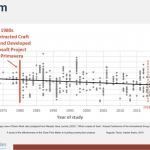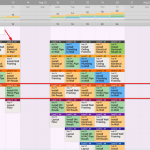Touchplan recently formed a technology partnership with BitRip, an adhesive tape that holds hundreds of ‘rippable’ codes that can store any cloud-based information on the spot. No set-up and no printers. These codes also track GPS position with each scan, so they can track the dynamic world around you.
BitRip is a simple technology that’s never been done before. We sat down with CEO Nicholas Dimitruk to learn more about the company’s technology and its impact on the construction industry.
What was the motivation for starting Bit Rip & what kind of impact do you think it can have on the industry?
Let me start that story by offering a simple question, what is a QR code? It’s a digital to physical connection. It’s a convergence between what you need to know and where you need to know, and this is such a powerful tool that doesn’t get the credit it deserves. When you use a QR code, it’s not like cancer is being cured or anything. It’s a simple, quick thing you didn’t even pay attention to, but it’s such a time saver.
And so what I believe – the digital to physical Connect is fundamentally crucial to dynamic industries like construction, manufacturing, supply chain logistics, you name it. Setting up a system of digital to physical connections instantly puts vital information in the hands of those who need it most.
Loads of time is wasted every day by people searching for information, especially on a jobsite. Think about the number of phone calls a typical foreman makes daily. It’s not uncommon for people to have 100 calls logged by lunch. Why? Most of the time, they’re trying to figure out what they’re supposed to do or describe a problem they are having with a scope of work. What if you could instead scan a room or a piece of equipment and instantly have the entire story right there at your fingertips?
So, if you can make that connection, in a split second, where someone knows that scanning a code gets right to the information, and they don’t have to second guess anything, that saves minutes every day; which turns into hours, days, and weeks throughout a job. I’m convinced that one of the biggest things to solve for, especially with dynamic industries like construction, is this connection. I’m confident that if they do that consistently, there is significant ROI to be realized quickly.
And that’s not just for standstill stuff; that’s also for dynamic things. That’s materials and asset tracking, knowing accurate information; what it is, who sends it, where it comes from and where it’s going. That is the real untapped power with BitRip. A Democratized barcoding system. It’s not just about getting the information; it’s the exchange of information. BitRip can sit in a place and listen. It can say that a worker scanned me at that time and make that data useful. It makes a small event monumental on a macro scale.
You have clearly shown the importance of the digital to physical connection, so the next question would most likely be, why hasn’t this happened already? Why aren’t QR codes being put up all over jobsites?
You get on a desktop computer. And you figure out all the digital stuff you want to connect to the physical; let’s just call it “a shared spreadsheet.” You will need a spreadsheet for every code. Now you have numerous sheets open on your browser that you want to attach to the physical world, which you then have to go to an outside software to translate those web addresses into unique QR codes. You then have to label those QR codes because you don’t want to mix and match them as they all look the same. We want to make sure this QR code goes to room one, this QR code goes to room two, and so on.
Do you see how cumbersome that process is? There are still more steps involved.
Next, you’ve got to organize them on a piece of paper. So you print maybe hundreds of these things. And it’s your hope you didn’t make a mistake because if you make a mistake, you have to go back to the office and start configuring and printing again. After printing, you go out in the field and carefully make the hundreds of matches – finding smooth flat surfaces to stick the labels. And then you hope that nobody accidentally rips them down because once again, it’s back to the office and the printer to plug the hole in the QR system.
Bottom line: existing QR systems are fragile and time-consuming. They aren’t widely adopted because they often require a dedicated person to manage labeling and tracking.
Hearing all that, one may think that the physical to digital connection has failed?
Yes, you might think that, but it’s not the digital-physical connect that is the issue; it’s the current delivery mechanism. Everything else apart from that is beautiful. And so, what BitRip has done is not reinvent QR code but reinvented the delivery mechanism.
So now, instead of being tethered to the office, you have a phone and a roll of tape; and that’s all you need. So you can rip and stick this tape on any surface. It can be flat; it could be a wire; it can be wrapped around a handle. When you create a label in BitRip, it’s dynamic. It’s not hardwired to one address; it can be any address or any collection of addresses at any time. If it gets damaged, it doesn’t have to be re-programmed. Just stick a new strip of tape and link the data from the damaged tag.
And if someone were to take the label off, all the user would have to do is find it on their phone, paste it onto a brand new piece of tape, and it’s done. Now we can say construction, manufacturing, supply chain logistics; you have no excuse. You can paste your software across the physical world and make that connection happen. And that connection lives, breathes, and does not go away. It’s a rugged connection. And now you start realizing the tremendous benefits of that digital – physical connection.
What is the value of partnering with Touchplan?
Touchplan and BitRip are both frontline tools focused on outputs, which makes us such a great fit. Touchplan helps doers plan and communicate digitally, and BitRip is a conduit to the physical world. Together, we hope to leverage the things we do well to create a process that field teams can better plan and communicate around workflows. We would allow them to walk back and forth over a digital bridge vice walking back and forth to the job trailer. BitRip provides less ambiguity, fewer one-off phone calls, and ultimately more uptime by connecting the field users’ tech stack to locations and equipment.
We hope that together, we are an indispensable tool for people who live in the field. Everyone on the jobsite already uses tape and a phone, so there is no additional learning curve associated with hardware. Couple that with the simplicity of both Touchplan and BitRip, and you have a combination that is easy to implement. We are opening the tech world to a new user base.
Where are you seeing some of the heavier uses of BitRip at the moment?
We see a lot of interest in BitRip with companies leveraging prefabrication. Users are sticking tape with all the instructions for everything related to a piece of equipment or work package. Once it is scanned by the next person in the supply chain, they are simultaneously getting the most up-to-date information about that item and stamping a GPS location to it. They are getting information to the end-user quickly while simultaneously telling a story.
How do folks access BitRip?
Right now, it’s available as a mobile app, but we will also have a desktop application by the end of the year. The desktop will have two fundamental features, which will allow users to build data upfront, and then connect it afterward to the physical world. And it will also let you export that data outside of BitRip. The Desktop is a Premium Subscription, but the mobile apps are completely free, no paywalls or data limitations.
The tape itself is pretty easy to get – you buy it straight off our website BitRip.com or through any of our channel partners – Ram Tool, SiteBiotics, and WESCO.
Interested in being a technology partner with Touchplan? Contact Andrew Piland or visit our Partnership Page.










